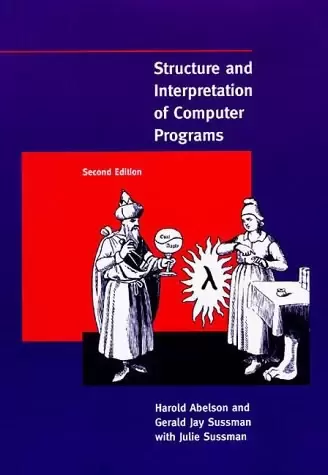
作者:HaroldAbelson/GeraldJaySussman/JulieSussman
出版社:TheMITPress
出版年:1996-7-25
页数:657
定价:USD145.56
装帧:Hardcover
ISBN:9780262011532
内容简介
······
Structure and Interpretation of Computer Programs has had a dramatic impact on computer science curricula over the past decade. This long-awaited revision contains changes throughout the text. There are new implementations of most of the major programming systems in the book, including the interpreters and compilers, and the authors have incorporated many small changes that reflect their experience teaching the course at MIT since the first edition was published. A new theme has been introduced that emphasizes the central role played by different approaches to dealing with time in computational models: objects with state, concurrent programming, functional programming and lazy evaluation, and nondeterministic programming. There are new example sections on higher-order procedures in graphics and on applications of stream processing in numerical programming, and many new exercises. In addition, all the programs have been reworked to run in any Scheme implementation that adheres to the IEEE standard.
作者简介
······
Hal Abelson is Class of 1922 Professor of Computer Science and Engineering at Massachusetts Institute of Technology and a fellow of the IEEE. He is a founding director of Creative Commons, Public Knowledge, and the Free Software Foundation. Additionally, he serves as co-chair for the MIT Council on Educational Technology.
Gerald Jay Sussman is the Matsushita Professor of Electrical Engineering in the Department of Electrical Engineering and Computer Science, Massachusetts Institute of Technology. He is also the coauthor of Structure and Interpretation of Computer Programs (MIT Press, second edition, 1996).
目录
······
Foreword
Preface to the Second Edition
Preface to the First Edition
Acknowledgments
1 Building Abstractions with Procedures
1.1 The Elements of Programming
1.1.1 Expressions
1.1.2 Naming and the Environment
1.1.3 Evaluating Combinations
1.1.4 Compound Procedures
1.1.5 The Substitution Model for Procedure Application
1.1.6 Conditional Expressions and Predicates
1.1.7 Example: Square Roots by Newton's Method
1.1.8 Procedures as Black-Box Abstractions
1.2 Procedures and the Processes They Generate
1.2.1 Linear Recursion and Iteration
1.2.2 Tree Recursion
1.2.3 Orders of Growth
1.2.4 Exponentiation
1.2.5 Greatest Common Divisors
1.2.6 Example: Testing for Primality
1.3 Formulating Abstractions with Higher-Order Procedures
1.3.1 Procedures as Arguments
1.3.2 Constructing Procedures Using Lambda
1.3.3 Procedures as General Methods
1.3.4 Procedures as Returned Values
2 Building Abstractions with Data
2.1 Introduction to Data Abstraction
2.1.1 Example: Arithmetic Operations for Rational Numbers
2.1.2 Abstraction Barriers
2.1.3 What Is Meant by Data?
2.1.4 Extended Exercise: Interval Arithmetic
2.2 Hierarchical Data and the Closure Property
2.2.1 Representing Sequences
2.2.2 Hierarchical Structures
2.2.3 Sequences as Conventional Interfaces
2.2.4 Example: A Picture Language
2.3 Symbolic Data
2.3.1 Quotation
2.3.2 Example: Symbolic Differentiation
2.3.3 Example: Representing Sets
2.3.4 Example: Huffman Encoding Trees
2.4 Multiple Representations for Abstract Data
2.4.1 Representations for Complex Numbers
2.4.2 Tagged data
2.4.3 Data-Directed Programming and Additivity
2.5 Systems with Generic Operations
2.5.1 Generic Arithmetic Operations
2.5.2 Combining Data of Different Types
2.5.3 Example: Symbolic Algebra
3 Modularity, Objects, and State
3.1 Assignment and Local State
3.1.1 Local State Variables
3.1.2 The Benefits of Introducing Assignment
3.1.3 The Costs of Introducing Assignment
3.2 The Environment Model of Evaluation
3.2.1 The Rules for Evaluation
3.2.2 Applying Simple Procedures
3.2.3 Frames as the Repository of Local State
3.2.4 Internal Definitions
3.3 Modeling with Mutable Data
3.3.1 Mutable List Structure
3.3.2 Representing Queues
3.3.3 Representing Tables
3.3.4 A Simulator for Digital Circuits
3.3.5 Propagation of Constraints
3.4 Concurrency: Time Is of the Essence
3.4.1 The Nature of Time in Concurrent Systems
3.4.2 Mechanisms for Controlling Concurrency
3.5 Streams
3.5.1 Streams Are Delayed Lists
3.5.2 Infinite Streams
3.5.3 Exploiting the Stream Paradigm
3.5.4 Streams and Delayed Evaluation
3.5.5 Modularity of Functional Programs and Modularity of Objects
4 Metalinguistic Abstraction
4.1 The Metacircular Evaluator
4.1.1 The Core of the Evaluator
4.1.2 Representing Expressions
4.1.3 Evaluator Data Structures
4.1.4 Running the Evaluator as a Program
4.1.5 Data as Programs
4.1.6 Internal Definitions
4.1.7 Separating Syntactic Analysis from Execution
4.2 Variations on a Scheme — Lazy Evaluation
4.2.1 Normal Order and Applicative Order
4.2.2 An Interpreter with Lazy Evaluation
4.2.3 Streams as Lazy Lists
4.3 Variations on a Scheme — Nondeterministic Computing
4.3.1 Amb and Search
4.3.2 Examples of Nondeterministic Programs
4.3.3 Implementing the Amb Evaluator
4.4 Logic Programming
4.4.1 Deductive Information Retrieval
4.4.2 How the Query System Works
4.4.3 Is Logic Programming Mathematical Logic?
4.4.4 Implementing the Query System
5 Computing with Register Machines
5.1 Designing Register Machines
5.1.1 A Language for Describing Register Machines
5.1.2 Abstraction in Machine Design
5.1.3 Subroutines
5.1.4 Using a Stack to Implement Recursion
5.1.5 Instruction Summary
5.2 A Register-Machine Simulator
5.2.1 The Machine Model
5.2.2 The Assembler
5.2.3 Generating Execution Procedures for Instructions
5.2.4 Monitoring Machine Performance
5.3 Storage Allocation and Garbage Collection
5.3.1 Memory as Vectors
5.3.2 Maintaining the Illusion of Infinite Memory
5.4 The Explicit-Control Evaluator
5.4.1 The Core of the Explicit-Control Evaluator
5.4.2 Sequence Evaluation and Tail Recursion
5.4.3 Conditionals, Assignments, and Definitions
5.4.4 Running the Evaluator
5.5 Compilation
5.5.1 Structure of the Compiler
5.5.2 Compiling Expressions
5.5.3 Compiling Combinations
5.5.4 Combining Instruction Sequences
5.5.5 An Example of Compiled Code
5.5.6 Lexical Addressing
5.5.7 Interfacing Compiled Code to the Evaluator
References
List of Exercises
Index
评论 ······
编程课的教材。老师把这本书中原本用scheme写的程序都翻译成javascript了。
看了前三章,没做习题,最多看懂了两成内容吧,但是依然收获很大。一方面满足了好奇心,另一方面学会了一些实用的编程原则。
就内容的广度和趣味性来说,无疑是本好书,
但就其定位(初学者用书)来说,绝对是本烂书。
:
TP31/A141.1/2nd ed./
评论前必须登录!
注册